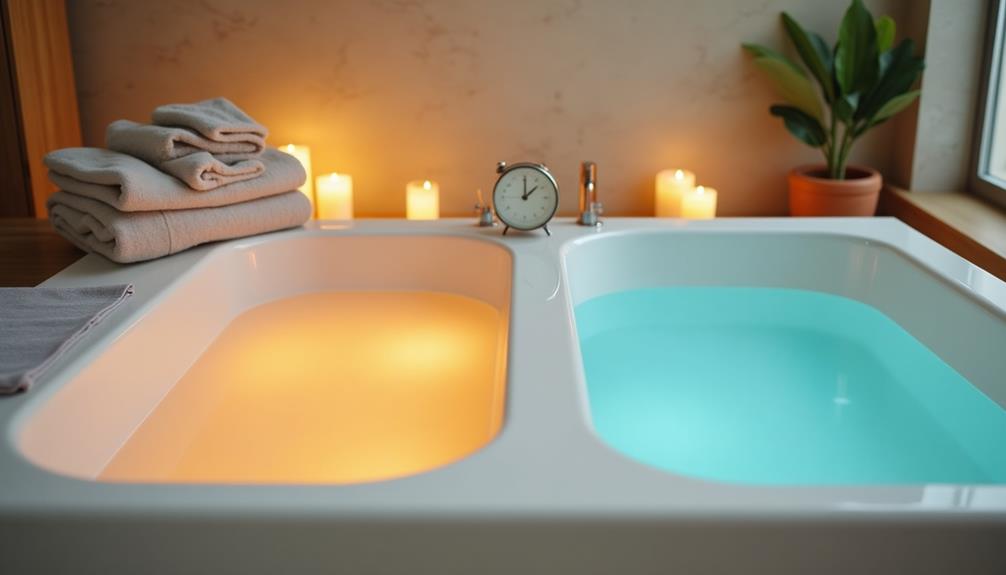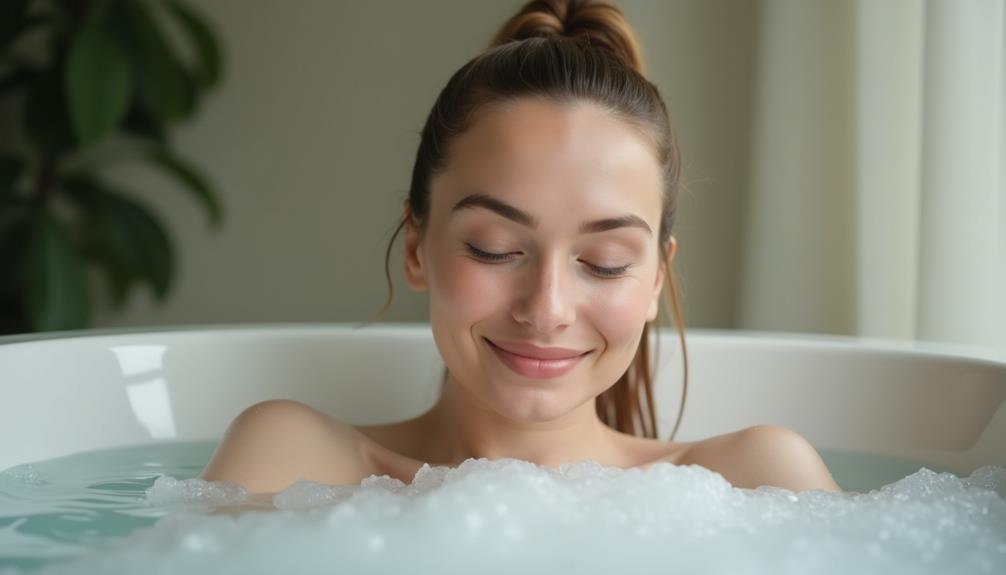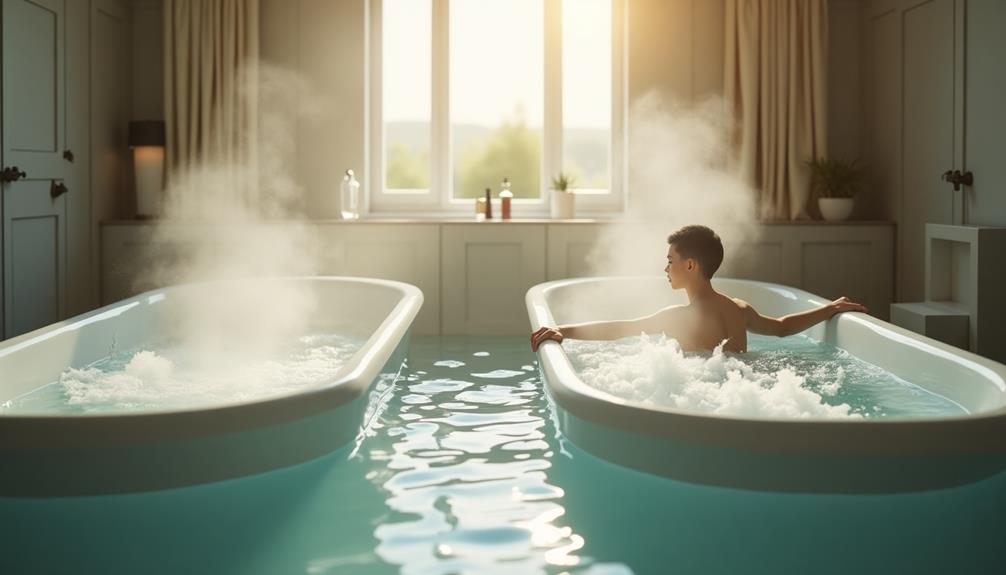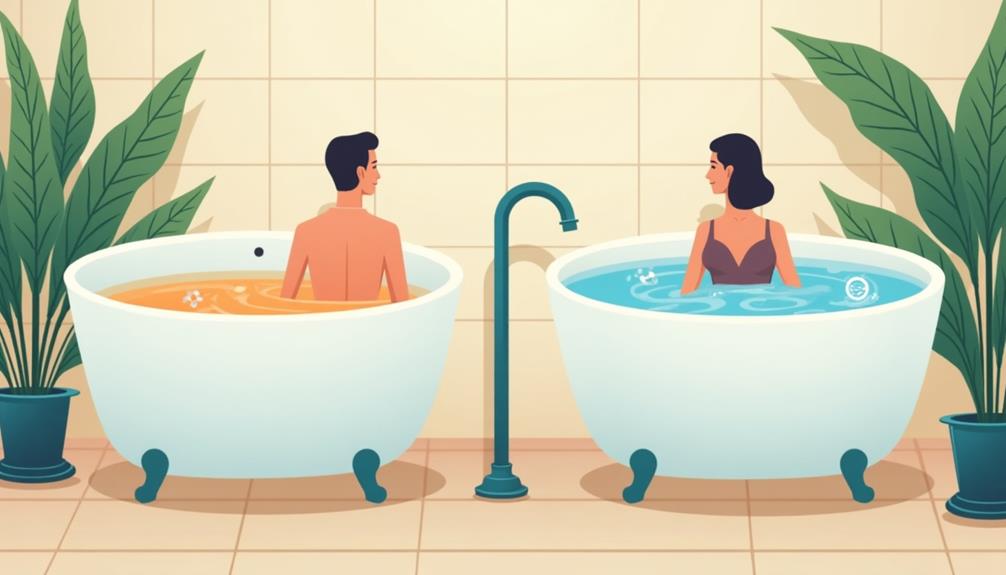Using contrast baths is an effective way to boost recovery after workouts. Start by preparing your space with access to hot and cold water. During your session, alternate between 3-5 minutes in warm water and cold water for 20-30 minutes total. This process enhances blood circulation, reduces inflammation, and helps flush out metabolic waste. Aim for 2-3 sessions a week, especially after intense activity. Remember to set a timer, stay hydrated, and adjust temperatures to your comfort level. By incorporating these baths correctly, you can optimize your recovery and enhance performance, paving the way for further insights ahead.
Core Insights
- Start with a comfortable setup, ensuring access to both hot and cold water for easy transitions during the session.
- Alternate between hot and cold baths for 3-5 rounds, maintaining a 3-4 minute duration per bath.
- Use a timer to keep track of each segment and ensure consistent timing for effective recovery.
- Stay hydrated before and after the session to support overall recovery and enhance benefits.
- Listen to your body's signals, adjusting temperatures or durations as needed to avoid discomfort.
What Are Contrast Baths?

Contrast baths are a popular recovery technique that alternates between hot and cold water immersion. This method typically involves soaking in hot water for three to four minutes, followed by a similar duration in cold water. You can repeat this cycle several times, creating a stimulating effect on your circulatory system. Ice bath enthusiasts often incorporate contrast baths into their post-workout routines to maximize recovery benefits.
The hot water helps to relax your muscles and improve blood flow, while the cold water reduces inflammation and numbs soreness. This back-and-forth immersion also aids in flushing out metabolic waste from your muscles.
If you're considering trying contrast baths, it's crucial to make sure that you have access to both hot and cold water sources. Always listen to your body and consult a professional if you're unsure about the process.
Benefits of Contrast Baths

Engaging in contrast baths can offer numerous benefits for your recovery process. These baths, alternating between hot and cold water, can enhance circulation, reduce muscle soreness, and speed up recovery time. By exposing your body to varying temperatures, you promote blood flow, which helps flush out toxins and deliver nutrients more effectively.
| Benefit | Description | How It Helps |
|---|---|---|
| Improved Circulation | Alternating temperatures boost blood flow. | Reduces muscle fatigue and soreness. |
| Reduced Inflammation | Cold water helps decrease swelling. | Eases pain and discomfort. |
| Enhanced Recovery | Speedier recovery from workouts or injuries. | Prepares you for your next session. |
| Stress Relief | Warm water promotes relaxation. | Reduces overall stress levels. |
Incorporating contrast baths into your routine can be a game-changer for your recovery journey.
Preparing for Your Session

Next, choose a comfortable spot where you can easily switch between the two baths. Make sure you have a timer handy to keep track of your intervals. Finally, wear comfortable clothing that you can easily change out of after the session. With everything in place, you're ready to begin your contrast bath journey.
Step-by-Step Bath Process

Repeat this cycle, alternating between warm and cold baths for a total of three to five rounds. Maintain awareness of your body; if you feel uncomfortable, adjust the temperatures accordingly. Once you've completed your baths, gently dry off and allow your body to return to its natural temperature. You've now effectively utilized contrast baths for best recovery!
Duration and Frequency

When planning your contrast bath sessions, consider both duration and frequency to maximize recovery benefits. Typically, a session lasts around 20 to 30 minutes. You'll alternate between hot and cold water, spending about 3 to 4 minutes in each temperature.
For frequency, aim for 2 to 3 sessions per week, especially after intense workouts or competitions. This routine helps your body heal and reduces muscle soreness.
Here's a quick reference table for you:
| Duration | Frequency |
|---|---|
| 20-30 minutes | 2-3 times a week |
| 3-4 minutes hot | After intense workouts |
| 3-4 minutes cold | Post-competition |
| Adjust as needed | Listen to your body |
Following this approach can help enhance your recovery effectively.
Tips for Effective Recovery

To maximize the benefits of contrast baths, you should focus on a few key tips for effective recovery. First, make sure you maintain a consistent temperature difference between hot and cold water. This variation enhances circulation and aids muscle recovery. Next, set a timer for each bath segment; aim for about three to four minutes in hot water followed by one to two minutes in cold. Staying hydrated is also important, so drink plenty of water before and after your session. For additional muscle tension relief, consider incorporating acupressure mats into your recovery routine. These mats can complement the effects of contrast baths by targeting specific muscle groups. Additionally, pay attention to your body's signals. If you feel overly uncomfortable, adjust the temperatures or durations. Lastly, combine contrast baths with other recovery practices, like stretching and proper nutrition, to further enhance your overall recovery process.
Common Mistakes to Avoid

Many people make common errors when using contrast baths that can reduce their recovery advantages. First, don't skip the warm-up. Beginning with a warm bath readies your muscles and improves circulation. Next, avoid extreme temperatures. Water that's too hot or cold can startle your system rather than aid recovery. Additionally, be mindful of timing. Spending too much time in either temperature can lead to diminishing returns; aim for 3-4 minutes in each bath. Lastly, don't neglect hydration. Make sure you drink water before and after to replenish fluids lost during the process. Proper sizing and fit are essential for optimal comfort and effectiveness when using compression sleeves in conjunction with contrast baths, as they can enhance recovery benefits. By avoiding these pitfalls, you'll maximize the effectiveness of your contrast baths and support your recovery journey more efficiently.
Frequently Asked Questions
Can Children Safely Use Contrast Baths for Recovery?
Yes, children can safely use contrast baths for recovery, but you should consult a pediatrician first. Verify the temperatures are appropriate, and always supervise them during the process to guarantee their safety and comfort.
Are There Any Medical Conditions That Contraindicate Contrast Baths?
Studies show about 10% of people shouldn't use contrast baths due to conditions like hypertension or circulatory issues. Always consult your doctor first to confirm it's safe for you before trying this recovery method.
How Do Contrast Baths Compare to Ice Baths or Heat Therapy?
Contrast baths stimulate circulation and reduce muscle soreness differently than ice baths, which numb pain, or heat therapy, which relaxes muscles. You'll find contrast baths offer a unique blend of benefits for recovery.
Can I Use Essential Oils or Additives in My Baths?
Imagine a fragrant garden blooming around you. Yes, you can add essential oils to your baths! Just remember to dilute them first, ensuring a soothing experience that enhances relaxation without overwhelming your senses. Enjoy the bliss!
What Should I Do if I Feel Dizzy During a Session?
If you feel dizzy during a session, stop immediately. Sit down, breathe deeply, and hydrate. It's important to listen to your body; don't push through discomfort. Adjust water temperature next time if needed.

